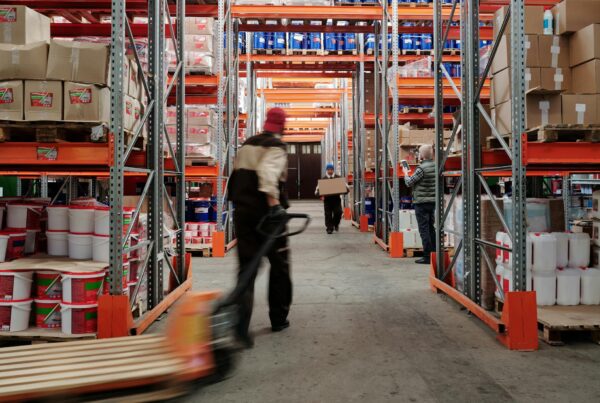Understanding the Role of Warehouses in Supply Chain Management
Like an expertly conducted symphony, the many moving parts of a supply chain must work harmoniously together to create a resounding success. At the heart of this complex composition, you’ll find the unsung hero – the warehouse. Far more than just storage spaces, modern warehouses are intricate hubs of activity, facilitating seamless operations and serving as vital links in the global supply chain.
From automotive to retail, from food and beverage to pharmaceuticals, each industry utilizes warehouses to meet its unique needs, optimizing their supply chain performance. They serve as buffers against supply chain disruptions, tools for managing sales fluctuations, and strategical leverage for cost reduction.
In this article, we delve into the various types of warehouses, measure their impact on the supply chain, and explore how to effectively manage their logistics. Whether it’s a distribution center bustling with activity or a climate-controlled facility maintaining optimal conditions for delicate goods, each type of warehouse has a key role to play.
Ready to embark on this journey of discovery? Let’s peel back the curtain and explore the incredible world of warehousing, where every storage rack and barcode scanner comes together in a perfect ballet of efficiency and organization, delivering unparalleled value in supply chain management. Let’s understand how warehouses help industries hit the high notes in their supply chain symphony.
What are the types of warehouses in supply chain management?
There are various types of warehousing systems relevant to batch manufacturers, each serving a different role in supply chain management. Here are some of them:
-
- Production Warehouses: These are warehouses located near or at the manufacturing facility. They are used for storing raw materials that are to be used in batch manufacturing as well as for storing finished goods awaiting distribution.
- Distribution Centers: These warehouses are a key node in the supply chain where products from various manufacturers are collected, sorted, and redistributed to retail outlets or directly to the customers. They usually have more complex operations such as packaging, labeling, and sometimes even light assembly.
- Cross-docking Warehouses: In this type of warehouse, products from suppliers are sorted and directly transferred to customers with minimal storage. It’s a practice aimed at reducing storage times and speeding up the delivery process, thus reducing inventory costs.
- Consolidation Warehouses: These warehouses receive shipments from different suppliers, then combine them into larger shipments going to the same destination. This strategy can be helpful in reducing shipping costs.
- Break-bulk Warehouses: These operate inversely to consolidation warehouses. They receive large shipments and break them down into smaller shipments for distribution to various locations. This type of warehousing is useful in the case where large batch shipments are manufactured but need to be distributed to multiple smaller retailers or end-users.
- Climate-Controlled Warehouses: Certain products may require specific storage conditions like controlled temperature or humidity. Climate-controlled warehouses are specially designed to keep products in optimal conditions.
- Bonded Warehouses: These are secured warehouse facilities where imported goods that have not yet had duty or VAT paid on them are stored.
- Third-Party Logistics (3PL) Providers: These are companies that provide a range of logistics services including warehousing, transportation, and sometimes even value-added services like packaging and assembly. They can handle a significant portion of the supply chain, allowing the manufacturer to focus on their core competencies.
- Just-in-Time Warehousing: This type of warehousing system aims to deliver the goods just as they are needed in the production process, thereby reducing the costs associated with holding inventory. It requires a high level of coordination and a reliable supply chain.
Each type of warehousing solution serves a specific purpose and offers distinct advantages. The choice among them largely depends on the particular requirements of the manufacturer, the nature of the goods, the structure of the supply chain, and the need for additional services like packaging or assembly. The right combination can lead to significant efficiencies and cost savings in supply chain management.
Measuring the impact of warehouses in the supply chain
Warehouses play a significant role in batch manufacturing industries, facilitating smooth operations and enabling companies to meet diverse market demands. Here are a few ways great companies leverage their warehouses to optimize their business.
Managing Supply Chain Risk and disruptions with inventory in warehouse.
Warehouses provide a buffer for batch manufacturers, mitigating the impact of supply chain disruptions. For instance, pharmaceutical companies often maintain strategic inventory in their warehouses to ensure uninterrupted supply, even in the face of raw material shortages or transportation delays. This effective supply chain management strategy keeps production lines running and prevents potential revenue loss.
Managing Sales fluctuations with warehousing.
In industries with highly variable demand, like enrobers during the holidays, warehouses serve a vital function. During periods of low demand, products can be safely stored without impacting production schedules. When demand spikes, stocked goods in the warehouse can quickly be distributed to meet market needs, thereby preventing stockouts and lost sales opportunities.
Managing Costs using warehouse to get bulk discounts.
Warehouses also offer financial advantages for batch manufacturers. For instance, companies in the chemical industry often leverage their storage capabilities to buy raw materials in bulk, securing discounts from suppliers. The purchased materials are then stored in the warehouse and used as required in production, resulting in significant cost savings and improved bottom-line performance.
How to manage logistics of a warehouse in a supply chain
Managing the logistics of a warehouse in a supply chain requires the implementation of specific tools and practices to optimize its operations. Here are some key areas to focus on:
Barcoding to track inventory
The implementation of an inventory barcode system is essential for efficient warehouse management. Such a system enables real-time tracking of goods from the moment they enter the warehouse until they leave. It improves accuracy, reduces the chance of errors, and saves time. An excellent example of this can be seen in the case of SDB Cosmetics who streamlined its inventory management and improvde its batch tracking capabilities improved with the help of Mar-Kov’s software.
Centralized Inventory Planning for Production Planning and MRP
Centralized inventory planning plays a crucial role in aligning production with demand. It allows for effective Material Requirements Planning (MRP), ensuring that sufficient raw materials are available for production and finished goods meet customer demand. This type of planning was successfully implemented by paint manufacturer Titan Coatings International, which used Mar-Kov’s solutions to achieve significant improvements in production planning and inventory management.
Order Tracking for Staging Production and Pick and Pack for Shipping
Order tracking systems provide visibility into the status of orders, guiding the staging process for production and helping orchestrate pick and pack activities for shipping. They allow the warehouse to efficiently manage the flow of goods, aligning with customer delivery expectations, and ensuring the right products are sent out on time.
Receiving and Testing Raw Materials
Proper procedures for receiving and testing raw materials are vital to ensure the quality and safety of the final products. This process typically includes inspection, sampling, and testing of raw materials upon receipt, and effective warehouse management ensures these activities are completed promptly and correctly.
Allergen Management and Inventory Segregation
In industries where allergenic ingredients are handled, allergen management and segregation are critical aspects of warehouse management. It involves the careful storage of allergenic ingredients separately from non-allergenic ones to prevent cross-contamination. Strict protocols and systems need to be in place to ensure that the separation is maintained throughout the handling process.
Concluding Thoughts
In the grand symphony that is supply chain management, warehouses serve as the conductors, ensuring every section comes in at the right time and hits the perfect note. From choosing the right type of warehouse to implementing cutting-edge tools like barcoding and centralized inventory planning, mastering warehouse logistics can turn a cacophonous operation into a harmonious masterpiece of efficiency and cost-effectiveness.
And now that you’ve learned about the virtuosos of the supply chain world, it’s time to step up to the podium and conduct your own masterpiece. Want to see how Mar-Kov can help your business orchestrate a symphony of success? Cue the drum roll, and click here for a demo. Because every maestro needs a little practice before the big performance. Let’s make some beautiful music together!




